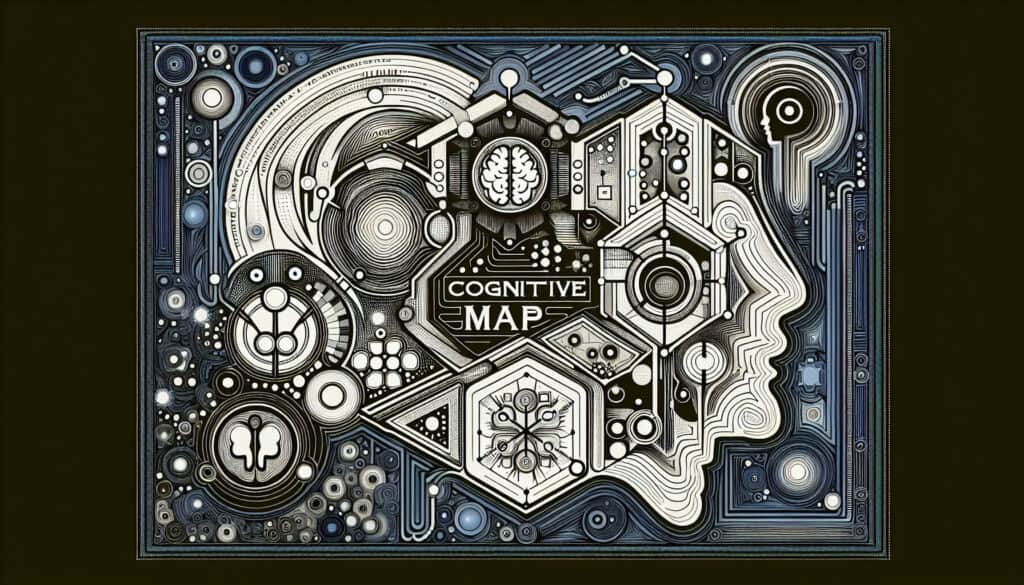A type of mental representation which serves an individual to acquire, code, store, recall, and decode information about the relative locations and attributes of phenomena in their everyday or metaphorical spatial environment.
- المنهجيات: العملاء والتسويق, الأفكار, تصميم المنتج
Cognitive Map

Cognitive Map
- الحوسبة الإدراكية, تخطيط رحلة العميل, عملية التصميم, التفكير التصميمي, التصميم المرتكز على الإنسان, التصميم التفاعلي, تجربة المستخدم (UX), واجهة المستخدم (UI), اختبار المستخدم
الهدف:
كيفية استخدامه:
- In design and research, it's a visualization tool used to represent a person's mental model of a particular concept or process, often looking like a network or web diagram.
الايجابيات
- Helps to understand a user's mental model and thought processes, can reveal misconceptions or opportunities for better design, and provides a rich, qualitative view of a user's understanding.
سلبيات
- Can be complex and time-consuming to create and analyze, the interpretation can be subjective, and it represents one person's perspective which may not be generalizable.
الفئات:
- الأفكار, حل المشكلات, تصميم المنتج
الأفضل لـ
- Visualizing and understanding a person's mental model of a system, concept, or process.
Cognitive mapping is widely applied in industries such as user experience design, education, and healthcare for understanding complex processes and enhancing user interactions. In the early stages of product development or research, this methodology is often initiated by designers, researchers, or product managers who seek to align their understanding of user needs with their product goals. It allows teams to visualize cognitive structures and reveal hidden assumptions about how users interact with a system, thereby informing design decisions and identifying potential areas for improvement. In educational contexts, instructors might use cognitive maps to help students organize and relate information, enhancing learning outcomes. In software development, cognitive maps can be beneficial during user testing phases, allowing developers to track where users might experience confusion or frustration. This technique can be implemented in workshops or collaborative sessions, where participants collectively build and share maps to merge their individual perspectives into a cohesive understanding of the challenges and opportunities within a system. By leveraging this qualitative approach, teams not only gain a deeper comprehension of user behaviors and scenarios but also strengthen communication and collaboration among stakeholders in the design process.
الخطوات الرئيسية لهذه المنهجية
- Identify the system, concept, or process to be mapped.
- Generate key concepts and components relevant to the topic.
- Define relationships between the concepts, including cause-effect linkages.
- Create a visual representation, organizing the concepts hierarchically or thematically.
- Iteratively refine the cognitive map based on feedback and evaluation.
- Analyze the cognitive map for patterns, misconceptions, and opportunities.
نصائح للمحترفين
- Incorporate grounded theory techniques during cognitive mapping sessions to capture emerging themes and relationships in user data.
- Utilize software tools that allow real-time collaboration and iteration of cognitive maps for enhanced stakeholder feedback.
- Apply scenario-based analysis alongside cognitive maps to address how different mental models influence user decisions in specific contexts.
لقراءة عدة منهجيات ومقارنتها, نوصي باستخدام
> مستودع المنهجيات الشامل <
مع أكثر من 400 منهجية أخرى.
نرحب بتعليقاتكم على هذه المنهجية أو المعلومات الإضافية على قسم التعليقات أدناه ↓، وكذلك أي أفكار أو روابط متعلقة بالهندسة.
السياق التاريخي
1848
1850
1854
1895
1914
1943
1970
1828
1850
1854
1854
1911
1928
1950
1980
(إذا كان التاريخ غير معروف أو غير ذي صلة، على سبيل المثال "ميكانيكا الموائع"، يتم تقديم تقدير تقريبي لظهوره الملحوظ)















منشورات ذات صلة
استبيانات الانزعاج العضلي الهيكلي
الاختبار متعدد المتغيرات (MVT)
تحليل الانحدار المتعدد
أنظمة التقاط الحركة
طريقة MoSCoW
اختبار متوسط المزاج